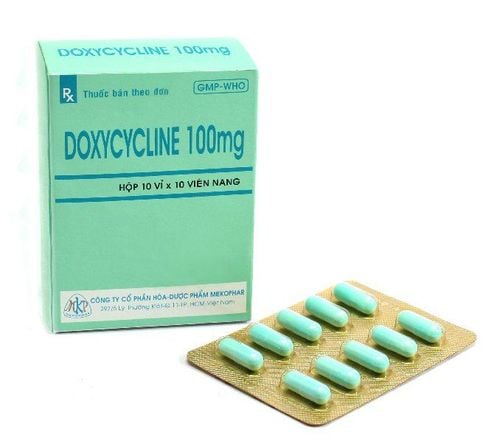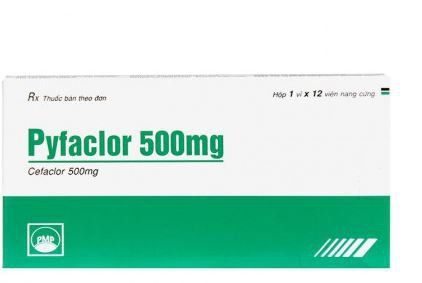This is an automatically translated article.
Altamet 250 is used to treat various types of bacterial infections. Altamet belongs to the group of antibiotics of the Cephalosporin group. It works by stopping the growth and spread of disease-causing bacteria.
1. What is Altamet?
Altamet 500 contains the main ingredient is Cefetamet Pivoxil Hydrochloride, which belongs to the group of drugs for parasites, anti-infectives, antivirals and antifungals. Altamet 500 is used in the treatment of the following diseases:
Treatment of infections caused by susceptible bacteria including: otitis media, sinusitis, pharyngitis-tonsillitis, exacerbation of chronic bronchitis , tracheobronchitis, pneumonia, urinary tract infections with or without complications, acute gonorrhea urethritis. Used in the treatment of community-acquired upper and lower respiratory infections. The main ingredient Cefetamet is strongly effective in the treatment of respiratory diseases caused by bacterial strains such as Streptococcus pneumoniae, Haemophilus influenzae, Moraxella catarrhalis and Group A hemolytic streptococci. Infections of other organs or used in combination with 1 other antibiotic to increase the effectiveness of treatment. Mechanism of action:
Ingredients Cefetamet is an antibiotic that has the ability to fight bacteria that produce the enzyme Lactamase. Thereby improving the ability to kill bacteria better. At the same time, the antibiotic Cefetamet has an advantage over other drugs in the Cephalosporin group that can kill some bacteria that are resistant to antibiotics of the Beta-lactam group.
2. Dosage and usage
How to use: Altamet 250 is prepared in the form of film-coated tablets. Take Altamet 250 by mouth as directed by your doctor, usually 2 times daily (every 12 hours) with meals.
Dosage: Dosage is based on your medical condition and response to treatment
For adults and children over 12 years old, the dosage is 500mg x 2 times/day.
For children under 12 years old use 10mg/kg x 2 times/day.
3. Contraindications
Absolutely do not use Altamet with patients who are allergic to the ingredients of the drug or have a history of allergy to drugs of the Cephalosporin group, penicillin or any other antibiotic with the Lactam structure.
4. Caution
Before using Altamet 250, patients need to check the quality and expiry date of the drug.
For patients with renal failure, on hemodialysis or peritoneal dialysis, the dose of Altamet 250 should be reduced in proportion to the degree of renal failure and creatinine clearance.
Most antibiotics can cause pseudomembranous colitis. Therefore, patients should be aware of this complication while taking the drug. Especially for patients with diarrhea when using the drug.
In case of mild colitis, the patient should stop taking the drug to reduce the disease, but in more severe cases, appropriate measures should be taken.
All groups of antibiotics are effective in killing pathogenic bacteria, but overuse can increase drug resistance. Therefore, patients should not use the drug for a long time.
For pregnant women and lactating women: Altamet 250 can cause adverse side effects to the health of pregnant women and babies. Therefore, pregnant and lactating women should consult a doctor before taking this medicine.
5. Side effects
Altamet 250 can cause some common side effects such as: Itching, erythema, fatigue, nausea and loss of appetite,... Most of these are mild and transient reactions that do not cause any serious side effects. serious harm to the patient's health. If you experience these symptoms, the patient should stop using Altamet 250 and notify the doctor for appropriate treatment.
6. Drug interactions
Drug interactions can change how well a drug works or increase the risk of serious side effects. Therefore, patients need to inform their doctors about the drugs they are using or have used to avoid interactions when using Altamet 250. The list of drugs when used together with Cefetamet ingredients includes: Possible interactions:
Abacavir : Cefetamet may decrease the rate of excretion of Abacavir, which may lead to higher serum concentrations of the drug. Abciximab: The therapeutic efficacy of Abciximab may be reduced when used in combination with Cefetamet. Aceclofenac: The risk or severity of nephrotoxicity may be increased when Aceclofenac is combined with Cefetamet. Acenocoumarol: The severity of bleeding may be increased when Cefetamet is combined with Acenocoumarol. Acetylsalicylic acid: The risk or severity of nephrotoxicity may be increased when Acetylsalicylic acid is combined with Cefetamet. Aclidinium: Cefetamet may decrease the rate of excretion of Aclidinium, resulting in higher serum concentrations of alendronic acid: The risk or severity of nephrotoxicity and hypocalcemia may be increased when Cefetamet is administered. with alendronic acid. Alteplase: The therapeutic efficacy of Alteplase may be reduced when used in combination with Cefetamet. Aminophenazone: The risk or severity of nephrotoxicity may be increased when Aminophenazone is combined with Cefetamet. Ampicillin Drugs: Cefetamet may decrease the excretion rate of Ampicillin, resulting in higher serum drug concentrations. To avoid interactions, before being prescribed Altamet 250, the patient should inform the doctor about the drugs they are using, including functional foods. The doctor will base on that to prescribe the appropriate Altamet 250.
Above is all information about Altamet 250, patients need to carefully read the instructions for use, consult a doctor / pharmacist before using. Note, Altamet 250 is a prescription drug, patients absolutely must not buy drugs and treat them at home because they may experience unwanted side effects.













